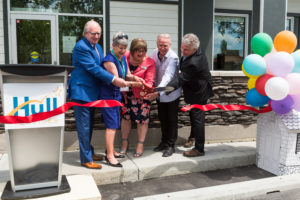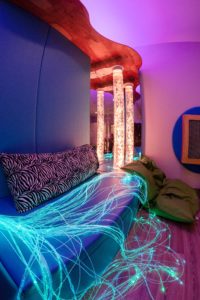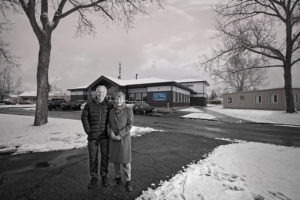Mike’s House: a new purpose built space for Alberta’s most vulnerable children
On June 5, 2019, Hull Services celebrated the new home of its Preadolescent Treatment Program, Mike’s House. The 10,914 sq ft new space replaces an existing facility, to better support the needs of a trauma informed group care setting.
“At Hull, we believe that physical environments are important to creating safety and supporting therapeutic relationships,” said Julie Kerr, Executive Director of Hull Services. “The bright, beautiful, thoughtfully appointed rooms in Mike’s House communicate to children and their families that they are valued and respected, that their comfort matters, and that they are in a good, safe place they can feel proud of and where they can have fun and create happy memories.”

Mike’s House Grand Opening ribbon cutting with, Bob Harris, CEO of Centron, left; Leslie Bissett, Hull Services Volunteer and Calgary Philanthropist; Julie Kerr, Hull Services Executive Director; Bruce D. Perry, M.D., Ph.D
PTP—a trauma informed therapeutic campus based care program serving children between five to 12 years—offers a predictable, nurturing environment. The original PTP building was built in the 1970s. “Over the last several years, there have been key contributions to our treatment knowledge and best practices such as, Milieu based therapy, our own practice based evidence, and advancements in the neurosciences,” says Shawn O’Grady, Program Director for the Preadolescent Treatment Program. “Each of these critical influences has demonstrated the importance of physical space and the essential role it plays to effective trauma informed care for children. With the opportunity to utilize this research and experience, the new building incorporates key concepts including sensory, self-regulatory, relational and cognitive based learning styles throughout the physical space.”
The opening of Mike’s House was emceed by Dave Kelly and included a presentation by Bruce D. Perry, M.D., Ph.D, internationally renowned expert in trauma, and author of The Boy Who Was Raised as a Dog. The Preadolescent Treatment Program is designed on the Neurosequential Model of Therapeutics (NMT) approach, an Evidence-Based Practice developed by Dr. Perry. In doing so, the program purports to a safe, predictable, nurturing and relationally rich environment designed to increase self-regulation, reduce high risk behaviours and improve connections to family and community by targeting specific areas in the brain for treatment.
“Creating a safe environment is the first step in helping our kids to heal. That ‘safety’ needs to include a safe physical space, nurturance, and predictability,” says Emily Y. Wang, Ph.D., R. Psych., Executive Manager, Advancement & Integration of Trauma Informed Practice at Hull Services. “When we first started implementing the NMT at the Preadolescent Treatment Program, we knew that there were some limitations due to the design of the old building.”
Dr. Wang states that in the original building, the staff at PTP had to be creative in finding appropriate physical space for the differing needs of the children. With one big common area, a kitchen, and a TV room, the noise level could at times be too much for an already dysregulated child. The new building was designed to provide more physical space options for staff to engage with children.
The new building has been purposely structured, with several setting conditions, which enhance safety and well-being for the children. The children have a therapeutic living space that allows for recreation and play, quiet spaces, and opportunities for relational connections for children and counsellors. “We paid attention to designing spaces that would work for differing needs, providing furniture that would give kids the choice of sitting in parallel with a staff or by themselves,” says Wang.
The building includes a music room where children can engage in drumming, singing, and other musical experiences with several of our counsellors who have their own unique musical talents that they share with the children.
A large basement area allows for free, unstructured recreational play, and provides opportunities for the children to be more physically active when the weather outside is not pleasant.
Additionally, there is a uniquely designed sensory room where children can engage in various sensory based activities that focus on brain activation and intervention.

Sensory Room in Mike’s House
“Basically everything we did from the moment we moved in was to ask ourselves what message we were sending the kids with the pictures on the wall, the colours we chose, and the space we created for them,” says Wang.
The leading-edge two-story, stand-alone building took 11 months to construct from breaking ground in 2018 to opening in 2019 and was built by Centron Real Estate Developments & Construction and designed by NORR Architects.
“Centron and NORR have been wonderful partners to work with, says O’Grady.” They allowed for a great deal of collaboration with our team, to ensure our expertise and input was valued and included in the design and development of the space. We were heavily involved in every aspect of the building and were regularly consulted along each step of the project. Not only did they complete the project ahead of time, they continue to provide many generous donations to Hull Services and have made significant financial contributions to support the children and families we serve.”
The project cost $4.6 million which was initiated with a lead transformational gift by Calgary philanthropist and Hull Services volunteer, Leslie Bissett. “As grateful as Hull is for the new building, Hull is equally grateful for Leslie’s investment of time in our children and at our program”, says Pat Foran, Assistant Program Director for the Preadolescent Treatment Program. “Leslie is highly invested in the success of the children that receive treatment in PTP and commits a significant amount of her time supporting the kids and families through her volunteer work. It was her fondness for the children and her belief in the work that PTP is doing that led to her vision of a new building.”

Pat Foran, Assistant Program Director for the Preadolescent Treatment Program, left; Leslie Bissett, Hull Services Volunteer and Calgary Philanthropist
The building’s name, Mike’s House, was chosen by Leslie as a symbolic gesture in recognition of a child with whom she has a special relationship. Leslie sought help for this family through her connection with Hull and her growing understanding of the NMT being implemented. This trauma informed approach is revolutionizing the way we understand children with trauma and mental health issues.
